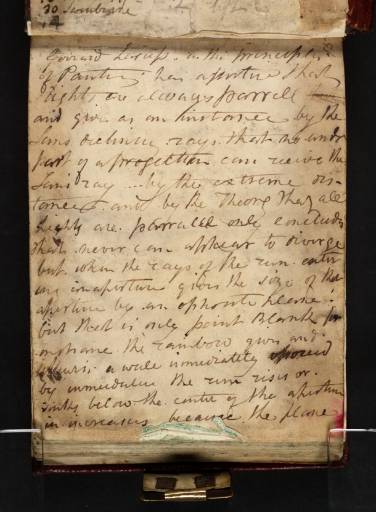Joseph Mallord William Turner Inscription by Turner: Notes on Sunlight c.1809
Joseph Mallord William Turner,
Inscription by Turner: Notes on Sunlight
c.1809
Joseph Mallord William Turner 1775–1851
Folio 91 Verso:
Inscription by Turner: Notes on Sunlight circa 1809
D07511
Turner Bequest CVIII 91a
Turner Bequest CVIII 91a
Pen and ink on white wove paper, 115 x 88 mm
Part watermark ‘J What | 180’
Inscribed by Turner in ink (see main catalogue entry)
Part watermark ‘J What | 180’
Inscribed by Turner in ink (see main catalogue entry)
Accepted by the nation as part of the Turner Bequest 1856
References
1909
A.J. Finberg, A Complete Inventory of the Drawings of the Turner Bequest, London 1909, vol.I, p.291, CVIII 91a, as ‘“Gerrard Larass, ...”’.
1969
John Gage, Colour in Turner: Poetry and Truth, London 1969, pp.178, 252 note 217.
1992
Maurice Davies, Turner as Professor: The Artist and Linear Perspective, exhibition catalogue, Tate Gallery, London 1992, pp.51, 108 note 85.
1994
Maurice William Davies, ‘J.M.W. Turner’s Approach to Perspective in his Royal Academy Lectures of 1811’, unpublished Ph.D thesis, Courtauld Institute of Art, London 1994, p.289.
The whole page is taken up with the following notes:
Gerrard Leir[...]ss, in the principles | of Painting has asserted that | lights are always parrell <...> | and gives as an instance by the | Suns declining rays that no undr | part of a projection can receive the | Sun’s ray ... by the extreme dis- | tance and by the Theory that all | Lights are parralel only concludes | that never can appear to diverge | but when the rays of the sun enter | ing an aperture gives the size of that | aperture by an opposite plane, | but that is only point Blank, for | instance the rainbow gives and | illu[?mines] a wall immediately oposed | by immediately the sun rises or | sinks below the centre of the aperture | it increases because the plane
This is the beginning of a passage which continues on the recto of the leaf (D07510) and on further pages back to folio 82 verso (D07493). John Gage has discussed these provisional notes (not developed in the perspective lectures) as an example of Turner’s close observation of natural phenomena,1 in this case the question of sunlight travelling in parallel lines or otherwise, responding to The Art of Painting by Gérard de Lairesse (1640–1711),2 in the English translation by John Frederick Frisch (London 1738 and later editions).3 Maurice Davies has registered Turner’s notes as ‘on light and shadow’, as part of a longer sequence running back to folio 72 verso (D07473).4
The key passages of Lairesse’s text (1738 edition) occur in Book V (‘Of Lights and Shades’). Chapter XV is headed: ‘Of the Sun’s Light upon Objects at Rising and Setting’. The chapter opens as follows on pages 229–30 (the italics are as printed):
It is unaccountable in many Artists, who handle an Art, whose Theory is built on Mathematics; its Practice, on Experience; and the Execution on Nature; that they take so little Notice of the three Points wherein lies their Honour; especially in the lighting of Objects in a Sun-set; for the Sun, how low soever, cannot shine on any Object under the Parallels, namely, not in the least from underneath, were the Object, if I may say so, as high as the Clouds; and yet we see many Paintings, wherein the Objects are, by a Sun-set, more lighted from underneath than above: which is contrary to Nature ...
This may be plainly evidenced by Perspective; to wit, that, as the Horizon limits our Sight, and the Sun cannot, with respect to the Eye, descend lower; therefore he cannot send his rays upwards, but along the Ground, or parallel.
Referring to plate XLII of his book, Lairesse continues on page 230:
... we see an high Building, with a projecting Cornice running towards the Point of Sight; and, on the other Side, an High Column ... Fetch [a] Ray from the Front or Cornice to the Sun’s Center, to find how much Shade the Projecture will throw on the Frize [sic] ... Then you will perceive, that the Joints of the Stones in the Building will be parallel with the Sun’s Rays, ... and the Frize will be parallel with the Ground.
The argument ends on page 231:
Suppose, for Instance, a Column, six Feet high, lighted by a Sun-set; if this column throw any visible Shade on the Ground, the Ground must have some Light; and, if so, how is it possible, that the Sun should shine from above and from below at the same Time? And if it be granted, that the Sun does not light the Column on Top, it’s Ground-shade must needs be infinite; in which Case, the Capital ought to be just lighted from underneath, and the Ground, of Necessity, to be without Light. This is an undeniable Truth, though the Point be little handled by Writers; even, seldom heard by Masters: ’Tis also no wonder to see some fail in it; the most probable Reason for which (as I think) is their Ignorance in Perspective.
Turner seems to have taken this caustic conclusion as a challenge to his own understanding of perspective and light as demonstrated in his art, as his extensive if inconclusive notes here and working back through the sketchbook demonstrate.
Alain Roy, ‘Lairesse, Gérard de’, Grove Art Online, accessed 1 May 2008, http://www.oxfordartonline.com .
Technical notes:
The middle of the outer edge is folded back, whether by accident or design, following the profile of the brass clasp attached to the adjacent back cover (D07354).
Matthew Imms
June 2008
How to cite
Matthew Imms, ‘Inscription by Turner: Notes on Sunlight c.1809 by Joseph Mallord William Turner’, catalogue entry, June 2008, in David Blayney Brown (ed.), J.M.W. Turner: Sketchbooks, Drawings and Watercolours, Tate Research Publication, December 2012, https://www

